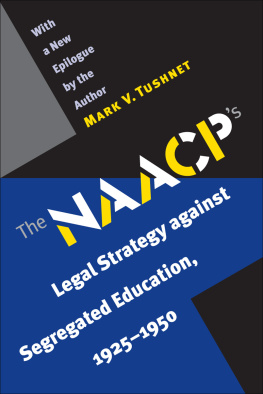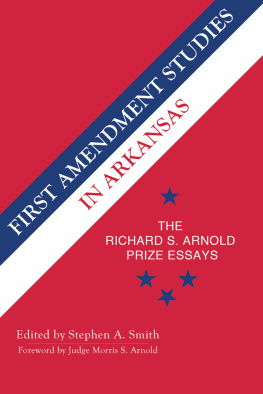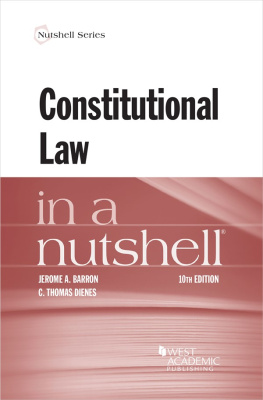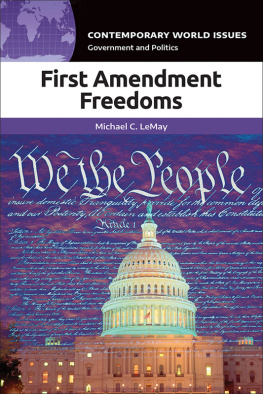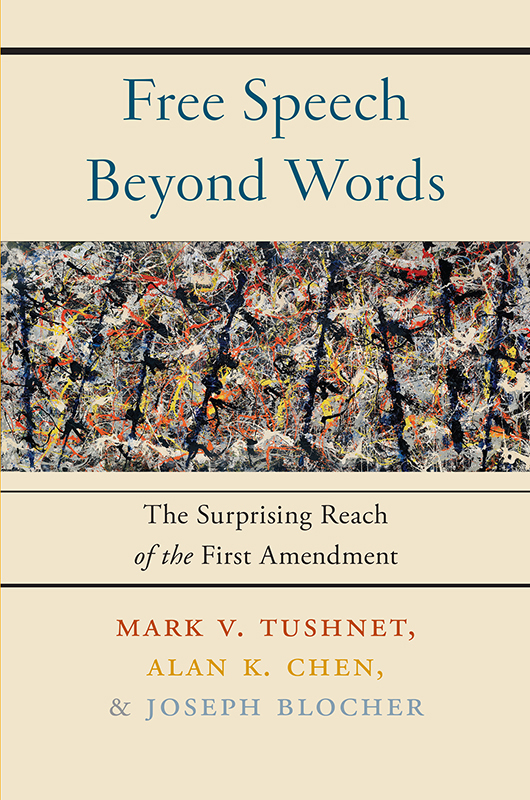
Free Speech beyond Words
Free Speech beyond Words
The Surprising Reach of the First Amendment
Mark V. Tushnet, Alan K. Chen, and Joseph Blocher

NEW YORK UNIVERSITY PRESS
New York
NEW YORK UNIVERSITY PRESS
New York
www.nyupress.org
2017 by New York University
All rights reserved
References to Internet websites (URLs) were accurate at the time of writing. Neither the author nor New York University Press is responsible for URLs that may have expired or changed since the manuscript was prepared.
ISBN : 978-1-4798-8028-7
For Library of Congress Cataloging-in-Publication data, please contact the Library of Congress.
New York University Press books are printed on acid-free paper, and their binding materials are chosen for strength and durability. We strive to use environmentally responsible suppliers and materials to the greatest extent possible in publishing our books.
Manufactured in the United States of America
10 9 8 7 6 5 4 3 2 1
Also available as an ebook
To my students
MVT
To my family and friends, who bring music into my life; you know who you are
AKC
To Marin, Ben, and Sam, who make it all meaningful
JB
Contents
The Supreme Court has unanimously held that Jackson Pollocks paintings, Arnold Schoenbergs music, and Lewis Carrolls poem Jabberwocky are unquestionably shielded by the First Amendment. Nonrepresentational art, instrumental music, and nonsense: all receive constitutional coverage under an amendment protecting the freedom of speech, even though none involves what we typically think of as speechthe use of words to convey meaning.
As a legal matter, the Courts conclusion is clearly correct; but its premises are murky, and they raise difficult questions about the possibilities and limitations of law and expression. Nonrepresentational art, instrumental music, and nonsense do not employ language in any traditional sense and sometimes do not even involve the transmission of articulable ideas. How, then, can they be treated as speech for constitutional purposes? What does the difficulty of that question suggest for First Amendment law and theory? And can law resolve such inquiries without relying on aesthetics, ethics, and philosophy?
These are serious challenges for the freedom of speech as it is generally conceived. If the First Amendment is the lodestar of our free speech culture, then it must be able to account for those forms of wordless expression, because they constitute an important type of human communication, both in everyday interaction and in the images, sounds, and actions that make up our cultural and artistic heritage. We express and understand each other through tone and silence, color and structure, rhyme and absurdity.
This book represents a sustained effort to account, constitutionally, for these modes of speech. We each address one of the categories that the Court confidently declares to be protected: Alan Chen focuses on instrumental music in chapter 1, Mark Tushnet on nonrepresentational art in chapter 2, and Joseph Blocher on nonsense in chapter 3. We employ varying methodologiesTushnet primarily relies on existing doctrine; Chen and Blocher draw more heavily on aesthetics and analytic philosophy, respectivelyand find different justifications for constitutional coverage. But our diverse inquiries reveal and engage overlapping themes and challenges.
I. First Amendment Coverage
As a legal matter, the threshold constitutional question is why the First Amendment should apply at all to forms of expression like nonrepresentational art, instrumental music, and nonsense, none of which involve speech in the typical sense. After all, the First Amendment does not even reach all language,
Answering the threshold question means charting the boundaries of the First Amendmenta fundamentally different task than exploring its established terrain. The distinction between the two is well captured by what Frederick Schauer has called the coverage/protection distinction. Coverage distinguishes those matters to which First Amendment analysis is relevanthanding out a political pamphletand those to which it is not, such as discharging polluted water from a factory. Protection distinguishes covered material that the government cannot ban or regulate from that which it can. Political speech in a public park, for example, is presumptively covered by the First Amendment but can still be banned under particular conditions and therefore might lack protection in certain circumstances.
As a doctrinal and scholarly matter, the threshold issue of coverage has traditionally not received nearly as much attention as the intricacies of protection. As Schauer puts it, the question whether the First Amendment shows up at all is rarely addressed, and the answer is too often simply assumed.
The need to understand First Amendment coverage has become all the more acute in recent years because the Supreme Court has demonstrated In doing so, the justices have also shown an appetite for bright-line rules instead of multifactor balancing testswhen the First Amendment applies, it does so with near-absolute force. This doctrinal development makes the threshold question of coverage even more pressing, because rules tend to collapse the distinction between coverage and protection by extending near-total protection to any speech that receives coverage.
The chapters here offer a new way to look at the question of coverage. Rather than exploring borderline cases, where one might plausibly wonder whether the subject being examined is covered or not, we test the distinction against cases where coverage is intuitively obvious but difficult to justify. Doing so makes it possible to reveal and evaluate not just the limits of First Amendment coverage but the possible reasons for it: extensions of existing doctrine, normative visions of free speech, nominalism, conventionalism, or something else entirely. This, in turn, can help make sense of the free speech law we have now and alsoas chapter 4 suggestshelp answer other questions of the same type.
Explaining the First Amendments coverage is as difficult as it is fundamental. Consider two appealing and commonly invoked approaches to the matter. One could say that the boundaries of the First Amendment are coterminous with language itself and that speech for constitutional purposes consists of words. But as Chen and Tushnet demonstrate in detail in chapters 1 and 2, let alone the Pollocks and Schoenbergs of the world.
One might try to avoid the problem of underinclusion by saying instead that the boundaries of the First Amendment are coextensive not with words per se but with the expression of ideas. In Miller v. California, for example, the Court held that [a]ll ideas having even the slightest redeeming social importanceunorthodox ideas, controversial ideas, even ideas hateful to the prevailing climate of opinionhave the full protection of the [First Amendments] guaranties.
But the focus on ideas is also unsatisfactory. Art and music express a great deal, but it would distort them tremendously to say that they must convey ideas in order to qualify for constitutional protection. As Chen and Tushnet demonstrate in chapters 1 and 2, art and music can convey a lot, but their power is not tied to the transmission of ideas as such. Blocher shows in chapter 3 that the same can be true even for words that convey no discernible meanings or ideassuch nonsense might nonetheless have a strong claim to constitutional coverage. It follows that ideas, like words, are not a reliable guide to the First Amendments reach.
Next page

